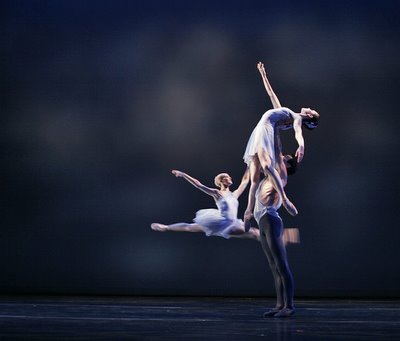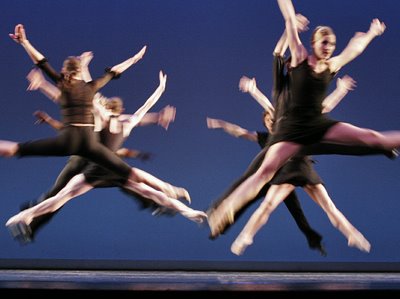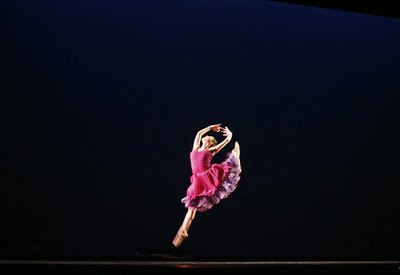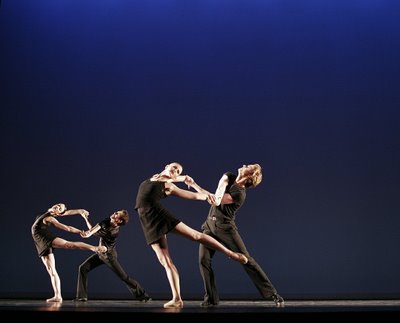Curving Space: Rebecca Kelly Ballet
Last night I saw the flowering of a new dance form. The elastic ballet that Rebecca Kelly has developed over the past Twenty-Five Years combines novel elements of movement and the traditional use of turnout with surprising fluidity. Unexpected turns of ankle, knee, hip and wrist, many from non-Western dance forms, together with sinuous backs, rippling shoulders and arms and innovative grips, curve the spaces around and between the dancers to create a level of intimacy that is at once modern and obvious as well as delicate
traditional use of turnout with surprising fluidity. Unexpected turns of ankle, knee, hip and wrist, many from non-Western dance forms, together with sinuous backs, rippling shoulders and arms and innovative grips, curve the spaces around and between the dancers to create a level of intimacy that is at once modern and obvious as well as delicate and lyrical. There are two new works: Air is a breathtaking piece for three dancers, set to the music of harper Martha Gallagher, in which the use of the spine certainly brings the human lungful into the picture, rather than just the amorphous stuff swirling around us, but nevertheless leaves an impression of weightlessness.
and lyrical. There are two new works: Air is a breathtaking piece for three dancers, set to the music of harper Martha Gallagher, in which the use of the spine certainly brings the human lungful into the picture, rather than just the amorphous stuff swirling around us, but nevertheless leaves an impression of weightlessness. Silver Circles, with music of the same name by Adrian Carr, features the interplay between a sizeable ensemble and two principles, starting from two distinct vocabularies that become merged. The Travelers, from 2002, set to music by the now-dismantled team of Craigmix, is about leaving the bumpy road of the quotidian journey in response to crisis, for multiple pas de deux that explore the realms of emergence and possibility.
Silver Circles, with music of the same name by Adrian Carr, features the interplay between a sizeable ensemble and two principles, starting from two distinct vocabularies that become merged. The Travelers, from 2002, set to music by the now-dismantled team of Craigmix, is about leaving the bumpy road of the quotidian journey in response to crisis, for multiple pas de deux that explore the realms of emergence and possibility.
all photographs by Adrian Buckmaster
Throughout the many innovative arabesques and lifts, Rebecca’s extensive use of attitude to the front and back creates both the sudden arachnid moment and greater warmth in partnering -- a warmth borne out as well through other lifts in second, and not a single limb anywhere used like a stick. Bourrées are never used to get around, but instead played out briefly in adagio from time to time as a contemplative moment, or to punctuate an ongoing narrative. Floor work is thoroughly mixed into the pas de deux, where there seem to be as many drops and slides as lifts, and makes the partnering look as tactile and organic as it has to be. In the narrative piece called Jose’s Dream, Therese Wendler, playing Carmen, uses discrete sets of gestures out of this extended vocabulary to switch back and forth quickly between coquette, seductress and lover, while Sasha Anatska and Alexander Forsythe, as Young and Old Jose respectively, play very different men even as they are brought together for a moment in absolute synchrony. Not to be missed, there is vocabulary enough still left to provide for a comic interlude that seems to be set at Bellevue.
tactile and organic as it has to be. In the narrative piece called Jose’s Dream, Therese Wendler, playing Carmen, uses discrete sets of gestures out of this extended vocabulary to switch back and forth quickly between coquette, seductress and lover, while Sasha Anatska and Alexander Forsythe, as Young and Old Jose respectively, play very different men even as they are brought together for a moment in absolute synchrony. Not to be missed, there is vocabulary enough still left to provide for a comic interlude that seems to be set at Bellevue.
The dancers in this production are superb. Like Rebecca herself, they bring experience from widely varying dance and cultural backgrounds (ABT, Budapest Opera, Riverdance, Ballet Metropolitan of Caracas, Joffrey, Suzanne Farrell, Boston Ballet, Raw Dance, the Opera NovaTheatre of Poland, Dance Theater of Harlem, to name a few) to make common cause for this new lexicon of movement.
the Opera NovaTheatre of Poland, Dance Theater of Harlem, to name a few) to make common cause for this new lexicon of movement.
Lighting by Tony Marques
Costumes by Anne-Alisa Belous, Andre Cornelius and Betty Crawford Heller
At the Gerald, W. Lynch Theater at John Jay College through March 11, 2006
 traditional use of turnout with surprising fluidity. Unexpected turns of ankle, knee, hip and wrist, many from non-Western dance forms, together with sinuous backs, rippling shoulders and arms and innovative grips, curve the spaces around and between the dancers to create a level of intimacy that is at once modern and obvious as well as delicate
traditional use of turnout with surprising fluidity. Unexpected turns of ankle, knee, hip and wrist, many from non-Western dance forms, together with sinuous backs, rippling shoulders and arms and innovative grips, curve the spaces around and between the dancers to create a level of intimacy that is at once modern and obvious as well as delicate and lyrical. There are two new works: Air is a breathtaking piece for three dancers, set to the music of harper Martha Gallagher, in which the use of the spine certainly brings the human lungful into the picture, rather than just the amorphous stuff swirling around us, but nevertheless leaves an impression of weightlessness.
and lyrical. There are two new works: Air is a breathtaking piece for three dancers, set to the music of harper Martha Gallagher, in which the use of the spine certainly brings the human lungful into the picture, rather than just the amorphous stuff swirling around us, but nevertheless leaves an impression of weightlessness. Silver Circles, with music of the same name by Adrian Carr, features the interplay between a sizeable ensemble and two principles, starting from two distinct vocabularies that become merged. The Travelers, from 2002, set to music by the now-dismantled team of Craigmix, is about leaving the bumpy road of the quotidian journey in response to crisis, for multiple pas de deux that explore the realms of emergence and possibility.
Silver Circles, with music of the same name by Adrian Carr, features the interplay between a sizeable ensemble and two principles, starting from two distinct vocabularies that become merged. The Travelers, from 2002, set to music by the now-dismantled team of Craigmix, is about leaving the bumpy road of the quotidian journey in response to crisis, for multiple pas de deux that explore the realms of emergence and possibility.all photographs by Adrian Buckmaster
Throughout the many innovative arabesques and lifts, Rebecca’s extensive use of attitude to the front and back creates both the sudden arachnid moment and greater warmth in partnering -- a warmth borne out as well through other lifts in second, and not a single limb anywhere used like a stick. Bourrées are never used to get around, but instead played out briefly in adagio from time to time as a contemplative moment, or to punctuate an ongoing narrative. Floor work is thoroughly mixed into the pas de deux, where there seem to be as many drops and slides as lifts, and makes the partnering look as
 tactile and organic as it has to be. In the narrative piece called Jose’s Dream, Therese Wendler, playing Carmen, uses discrete sets of gestures out of this extended vocabulary to switch back and forth quickly between coquette, seductress and lover, while Sasha Anatska and Alexander Forsythe, as Young and Old Jose respectively, play very different men even as they are brought together for a moment in absolute synchrony. Not to be missed, there is vocabulary enough still left to provide for a comic interlude that seems to be set at Bellevue.
tactile and organic as it has to be. In the narrative piece called Jose’s Dream, Therese Wendler, playing Carmen, uses discrete sets of gestures out of this extended vocabulary to switch back and forth quickly between coquette, seductress and lover, while Sasha Anatska and Alexander Forsythe, as Young and Old Jose respectively, play very different men even as they are brought together for a moment in absolute synchrony. Not to be missed, there is vocabulary enough still left to provide for a comic interlude that seems to be set at Bellevue.The dancers in this production are superb. Like Rebecca herself, they bring experience from widely varying dance and cultural backgrounds (ABT, Budapest Opera, Riverdance, Ballet Metropolitan of Caracas, Joffrey, Suzanne Farrell, Boston Ballet, Raw Dance,
 the Opera NovaTheatre of Poland, Dance Theater of Harlem, to name a few) to make common cause for this new lexicon of movement.
the Opera NovaTheatre of Poland, Dance Theater of Harlem, to name a few) to make common cause for this new lexicon of movement.Lighting by Tony Marques
Costumes by Anne-Alisa Belous, Andre Cornelius and Betty Crawford Heller
At the Gerald, W. Lynch Theater at John Jay College through March 11, 2006

<< Home